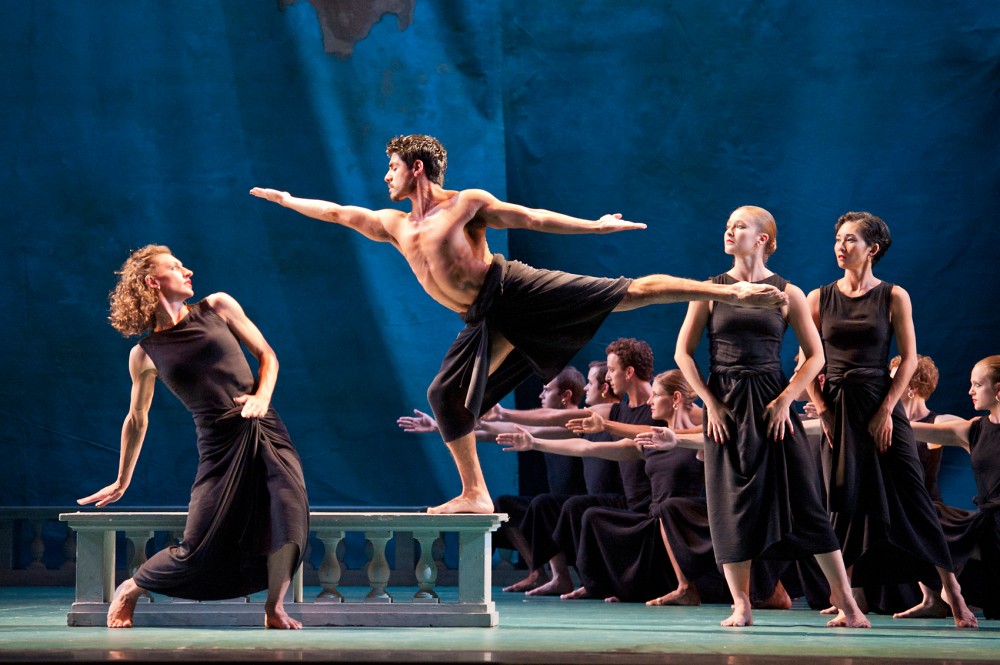Art rarely mashes up genres as disparate as modern dance, baroque opera and Roman epics.
Yet the Mark Morris Dance Group has been pulling off the combo since 1989.
For their modern dance version of Purcell’s opera, “Dido and Aeneas,” at Northrop on Wednesday, the 12 dancers are collaborating with a live orchestra, chorus and solo vocalists.
“It’s one of the great pieces of music in the Western canon and [one of the first operas] in the English language,” said Morris. In addition to leading his eponymous group, he’s the piece’s choreographer and the orchestra’s conductor.
With its hourlong duration, Morris remarked, the opera is the ideal length for a dance piece.
“It’s perfectly concise, and it’s one of the greatest stories ever from the Aeneid,” Morris said. “I loved it, so I decided to present it. I made [the choreography] up 30 years ago, and we’ve been doing it ever since.”
In 2000, Morris stopped performing the part of Dido and the evil Sorceress and wasn’t sure what the fate of the piece would be.
After a brief hiatus, he decided to revive the piece, this time as conductor.
“When I quit dancing [in the piece], I wasn’t sure that anyone else could do it,” Morris said. “I don’t resent that I’m not performing it. … It’s another way of being involved with it that’s wonderful.”
The opera itself is by English composer Henry Purcell, who wrote the piece in the mid-1690s. Purcell adapted from the tragic love story of Aeneas and Dido from Virgil’s Roman epic poem.
The poem follows Aeneas’ flight from Troy’s ruins and fated founding of Rome.
He is shipwrecked and waylaid in Carthage, where he meets and falls in love with the town’s founder and queen, Dido.
In the end, Aeneas must follow his destiny to Rome, leaving behind a heartbroken Dido. Ashamed of forgetting her own duty to Carthage, she kills herself.
While the basic story remains the same, Purcell makes significant changes to the narrative in his opera.
He makes Aeneas the “pursuer” of Dido, giving Dido more power in the relationship, and also replaces the Roman gods with witches.
These changes make the opera fascinating not only from an artistic perspective but also from an academic one.
“[The witches] are a different way of approaching the story,” said Kelley Harness, associate professor of musicology at the School of Music. “Many scholars think this is because there’s a larger political message … dated to the decade of the 1680s, which were politically turbulent in England’s history.”
Throughout the performance, the opera plays with the relationship dynamic between Dido and Aeneas.
Changing details about the couple’s interactions lead the opera’s romance in a different direction from the poem’s.
“When Aeneas decides to leave, [Dido] is heartbroken and outraged,” said Nita Krevans, professor in the Classical and Near Eastern Studies department. “The Aeneas in Virgil’s poem doesn’t change his mind. [In the opera], he changes his mind and offers to stay. But Dido says it doesn’t matter: Just the idea that he would leave her makes it impossible for them to ever be together again. That’s a big difference.”
These peripheral historical discussions and interpretations will be under the spotlight at Northrop on Wednesday night as the performance brings dance, music, history and literature together.
“I think it’s great to have these interdisciplinary things,” Harness said, “and I don’t mean ‘interdisciplinary’ only in the sense of varying academic disciplines but recognizing that performance and academic disciplines actually have something to say to each other.”
“Dido and Aeneas,” performed by Mark Morris Dance Group
Where Northrop, 84 Church St. SE, Minneapolis
When 7:30 p.m. Wednesday
Cost $49-74








